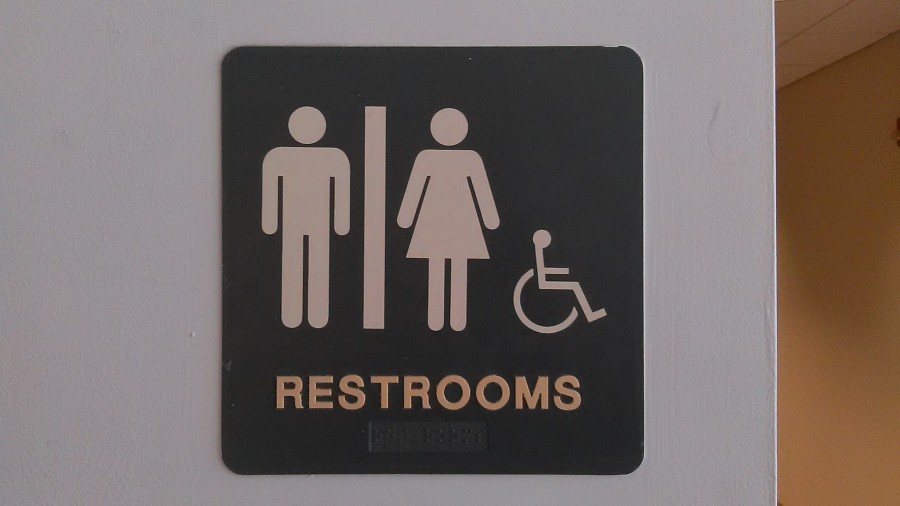A Stall to Action
February 12, 2015
When KC Everett finally looks up from a book and flashes a grin in Henry Ponder’s direction, a few things might catch your eye. It could be the bright red-colored contacts, the streaks of crimson hiding behind dark hair, or maybe it was the faux vampire fangs peeking out from under a top lip.
Everett and Ponder have dealt with their fair share of strange looks at Anne Arundel Community College, being a part of the small community of openly transgender students on campus.
“Most people know me as biologically male because they know me from high school,” says Everett, a music education major at AACC. “So I definitely get some weird looks from my peers. Especially when I’m wearing a dress.”
Across the country, more students are coming out as transgender. Much like statistics for lesbian, gay, and bisexual students, there are no reliable statistics for the exact number of transgender students on college campuses. However, through observation and anecdotal evidence, it’s obvious that there are more students who do not fit the gender binary of “male” and “female”.
The Gay & Lesbian Alliance Against Defamation (GLAAD) defines transgender as “an umbrella term for people whose gender identity differs from what is typically associated with the sex they were assigned at birth.”
According to a report by the University of Iowa, the main concerns of transgender students on college campuses are programming, educational programs, support services, campus housing, counseling, health care, campus records, locker rooms and bathrooms. Some of these issues are specific to four-year universities with on-campus housing, but after speaking with transgendered students at AACC, it’s clear that these concerns are shared by trans students even on a community college campus.
The biggest concern for AACC students seems to be the lack of gender-neutral bathrooms.
“It’s so awkward using the bathroom here,” says Everett. “I really don’t feel like I belong anywhere. I usually end up using the bathroom in the nurse’s office.”
Right now, the only gender- neutral bathroom on campus is in the health center in the Student Union building. However, the bathroom in the health center is only available to students from 8:30 a.m. to 4:30 p.m.
According to a study by the University of Massachusetts, more than 150 college campuses currently have gender-neutral bathrooms. The University of California San Diego has changed male/female signs on 88 single-stall restrooms in campus buildings. At The New College of California, all campus bathrooms are gender-neutral.
Even just 30 minutes down the road at the University of Maryland Baltimore County (UMBC) there are two explicitly gender-neutral bathrooms, and a few single-stalled bathrooms in academic buildings.
“We definitely need to work on it,” said Riley Gilooly, trans student and vice president of UMBC’s LGBTQ social club. “We’d like to add more gender-neutral bathrooms that are more accessible and easy to find.”
Gilooly says that other than backlash about whether to label the bathrooms “gender-neutral” or “family,” the bathrooms were well-received on UMBC’s campus.
The University of Maryland, College Park has more than 50 gender-neutral bathrooms on campus, as well as the option of gender-inclusive housing. Gender-inclusive housing means that students, regardless of sex, gender, or gender identity, share the same bedroom.
“I feel like the campus climate for trans students here is very welcoming,” said Tyler Barton, political science major and member of Pride Alliance, the University of Maryland’s LGTQ social club. “We have so many resources for LGBTQ students on this campus.”
Both Ponder and Everett say that while the overall atmosphere at AACC is accepting and understanding, they both still face their fair share of prejudice.
“One time I had a woman threaten to call the cops on me because she thought I was in the wrong bathroom,” says Ponder, who presents himself as masculine but identifies as transgender. “Yeah, I was in the women’s restroom because I’m biologically female, and this woman started screaming at me.”
Students in AACC’s Gay Straight Alliance want to change the signs on the single-stalled bathrooms on campus to make them unisex.
“This is an issue that I have addressed at my previous institutions,” said James Felton, chief diversity officer at AACC. “I’m happy to share best practices in exploring options at AACC.”
Felton is AACC’s first chief diversity officer, having taken office in July 2014. Felton is committed to meeting the needs of AACC’s increasingly diverse student body. He made it clear that he is not only committed to the needs of racial and ethnic minorities on campus, but also gender and sexual minorities. Prior to coming to AACC, Felton acted as inaugural director for intercultural affairs and an adjunct instructor for human services at Western Carolina University.
After talking with some trans students at different schools it’s become obvious: gender-neutral bathrooms are a key component of not only feeling comfortable on campus, but also safe.
“I just don’t get it,” said Everett. “Like, where are we supposed to go? You have your own bathrooms, why can’t we have ours?”












